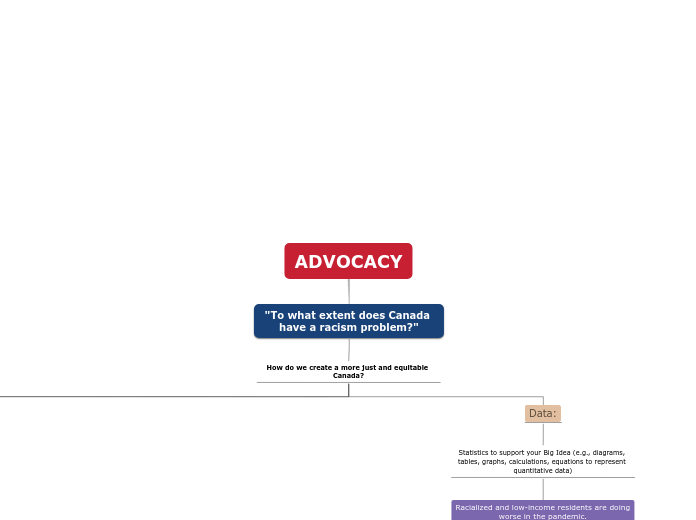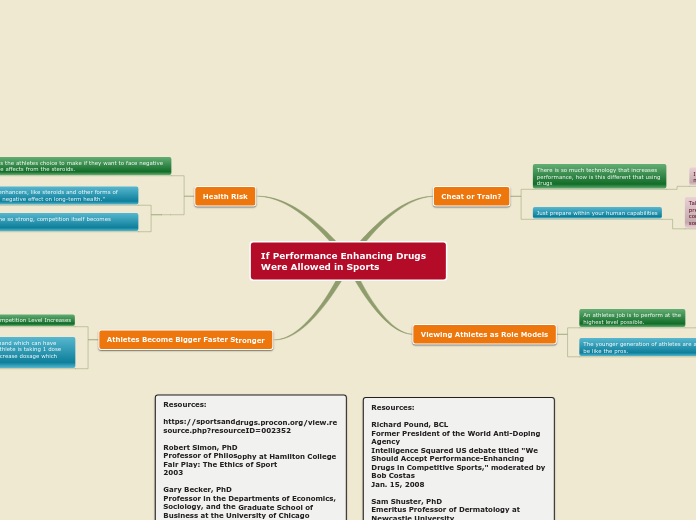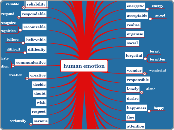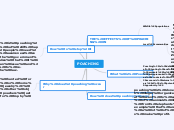ADVOCACY
Type in the name of the multiple-perspectives text.
Example: Bridge to Terabithia by Katherine Paterson
"To what extent does Canada have a racism problem?"
Identify an important issue from the text that is being presented from different angles. Type it in.
Example: Jesse's drawing talent.
How do we create a more just and equitable Canada?
Data:
Whose character does the third point of view belong to?
Type in his/her name.
Example: Mr. Aarons, Jesse's father.
Statistics to support your Big Idea (e.g., diagrams, tables, graphs, calculations, equations to represent quantitative data)
Racialized and low-income residents are doing worse in the pandemic.
Take Action:
Improving the social determinants of health for these racialized groups: establishing affordable homes and improving jobs, wages and employment rights.
We need to address the systemic racism to better understand the members of these communities and further create solutions to keep them safe.
Statistics
What does the character think, say or do that suggests their perspective on the issue?
Type in a quote and try to maintain the citation format.
Example: 'He would like to show his drawings to his dad, but he didn't dare. (...) He'd thought his dad would be pleased. He wasn't. What are they teaching in that damn school? he had asked.' (Paterson, 2.8)
Low-Income Groups:
30% of Toronto's population has a household income of $50,000 or less but that income group represents a little more than 50% of reported infections in the city. Low-Income groups are also overrepresented in data. (https://toronto.ctvnews.ca)
COVID-19 test positive rates increased as household income decreased. The infection rates were 24 per 100,000 in those living in households with more than 150K income and 160 per 100,000 in those with household incomes less than 30K. (https://www.wellesleyinstitute.com)
Racialized Groups:
What kind of narration introduces the viewpoint?
Choose an answer:
First person point of view - using the personal pronouns 'I' or 'we'Second person point of view - using the personal pronoun 'you'Third person point of view - using the third-person pronouns 'he', 'she' and 'they'Omniscient point of view - an all-seeing observer tells the story
Arab, Middle Eastern, West Asian, Latin American, South East Asian or Black communities were 6-9 times more likely to test positive for COVID-19 than the white population, from mid-May to July. (https://www.wellesleyinstitute.com)
Those who identify as Black represents 21% of reported COVID-19 cases in Toronto although they only account for 9% of the city's population. This tells us that they are over represented in the data. (https://toronto.ctvnews.ca)
Audience:
Decide on the second point of view
Name the character (it can either be the main character or one of the supporting characters) whose point of view you are presenting.
Example: Miss Edmunds, Jesse's music teacher.
Who needs to know this? Why? How are you going to let them know? Why is this the best format for this audience?
Residents and Government of Ontario
Type in a quote that points out the character's position about the issue.
Try to follow a citation format: author's name, chapter, and page.
Example: 'She said he was unusually talented, and she hoped he wouldn't let anything discourage him.' (Paterson, 2. 8)
Many consider Canada as a "nice" country. But what if that was just a façade? The stories and experiences of those who are oppressed are simply hiding behind a mask. We need to take off the mask to reveal the truth and have justice for those who have been wronged.
How is the viewpoint introduced in the story?
Choose an answer:
First person point of viewSecond person point of viewThird person point of viewOmniscient point of view
COVID-19 has brought light to the racial, health and economic inequalities in Canada.
I will be using a website because everyone will be able to view the data that I will be showcasing.
Big Idea:
Decide on the first point of view you are going to present.
Type in the name of the character (it can either be the main character or one of the supporting characters) whose point of view belongs to.
Example: Jesse Oliver Aarons, Jr., the main character of the novel, a fifth-grader living in a rural Southern area.
What/who are you advocating for?
I am adovocating for the racialized and low-income groups in Canada that are impacted by COVID-19.
Type in a relevant quote that highlights the character's point of view towards
Big Idea:.
Try following a citation format: author's name, chapter, and page.
Example: 'Jesse drew the way some people drank whiskey. (...) Lord, he loved to draw. (...) When he was in first grade, he told his father that he wanted to be an artist when he grew up.' (Paterson, 2. 7)









